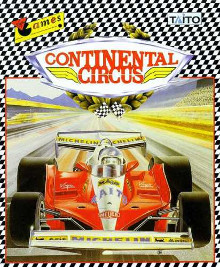This article needs additional citations for verification .(December 2012) |
| Continental Circus | |
|---|---|
 Commodore 64 Cover | |
| Developer(s) | Taito |
| Publisher(s) | Taito |
| Composer(s) | Zuntata |
| Platform(s) | Arcade, Amiga, Amstrad CPC, Atari ST, Commodore 64, MSX, ZX Spectrum |
| Release | |
| Genre(s) | Racing |
| Mode(s) | Single-player |
| Arcade system | Taito Z System [9] |
Continental Circus is a racing arcade video game developed and published by Taito in 1987. [10] In 1989, ports for the Amiga, Amstrad CPC, Atari ST, Commodore 64, MSX, and ZX Spectrum were published by Virgin Games.
Contents
The arcade version comes in both upright and sit-down models, both of which use shutter-type 3D glasses hanging above the player's head. According to Computer and Video Games in 1988, it was "the world's first three dimensional racing simulation". [10] The home conversions of Continental Circus lack the full-on 3D and special glasses of the arcade version.
Circus is a common term for racing in France and Japan, likely stemming from the Latin term for a racecourse.[ citation needed ]
In 2005, the game was made available for the PlayStation 2, Xbox, and PC as part of Taito Legends .
